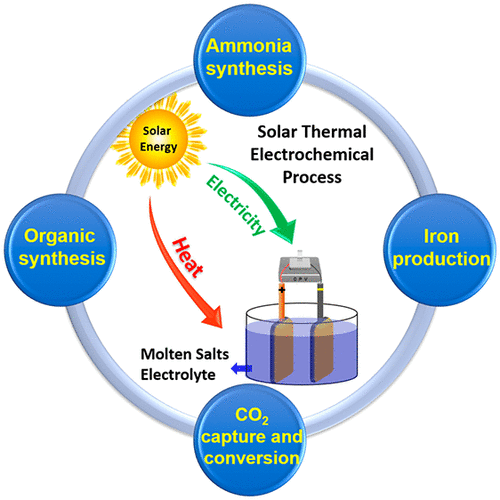当前位置:
X-MOL 学术
›
Acc. Chem. Res.
›
论文详情
Our official English website, www.x-mol.net, welcomes your
feedback! (Note: you will need to create a separate account there.)
Recent Advances in Solar Thermal Electrochemical Process (STEP) for Carbon Neutral Products and High Value Nanocarbons.
Accounts of Chemical Research ( IF 16.4 ) Pub Date : 2019-11-07 , DOI: 10.1021/acs.accounts.9b00405 Jiawen Ren 1 , Ao Yu 1 , Ping Peng 1 , Matthew Lefler 2 , Fang-Fang Li 1 , Stuart Licht 2
Accounts of Chemical Research ( IF 16.4 ) Pub Date : 2019-11-07 , DOI: 10.1021/acs.accounts.9b00405 Jiawen Ren 1 , Ao Yu 1 , Ping Peng 1 , Matthew Lefler 2 , Fang-Fang Li 1 , Stuart Licht 2
Affiliation

|
Climate change represents one of the most important environmental issues of our time. Due to high levels of anthropogenic CO2 emissions, atmospheric CO2 has for the first time ever exceeded 415 ppm and has increased from 315 ppm in 1950. An annual increase in atmospheric CO2 of ∼2 ppm is equal to a net increase of ∼15.6 billion tons of CO2. The combustion of fossil fuels for electricity and transportation is still the main reason accounting for the CO2 accumulation. On the top of that, fossil fuels are widely used in our modern industry for the productions of indispensable social staples. For instance, the millennia old thermal reduction of iron ore by charcoal or baked coal (3C + 2Fe2O3 → 4Fe + 3CO2) continues as the main method for the production of iron. The artificial fertilizer ammonia boosts the global population and is mainly produced from the Haber-Bosch process, in which hydrogen is generated via steam reforming of methane (CH4 + 2H2O → 4H2 + CO2). Sequestration and diminution of CO2 require the development of a portfolio of technologies on (1) efficient and long-term harvesting of renewable energy, that is, solar, not only for electricity but also directly as the energy force in vital chemical processes, wherever possible, (2) carbon-neutral processes to replace current industrial processes that emit vast amounts of CO2, such as iron and ammonia production, and (3) new, low-cost technologies for CO2 capture and conversion with particular interests in the exploration of CO2 as the feedstock for fuels or other valuable chemicals and materials. To this end, we conducted some studies on the sustainable synthesis of ammonia and iron with net-zero CO2 emissions and large-scale CO2 capture and conversion into fuels and high value nanocarbon products via electrolysis in molten salt(s) with the introduction of the Solar Thermal Electrochemical Process (STEP). In STEP, solar UV-visible energy is focused on a photovoltaic device that generates the electricity to drive the electrolysis, while concurrently the solar thermal energy is focused on a second system to generate heat for the electrolysis cell. The utilization of the full spectrum of sunlight in STEP results in a higher solar energy efficiency than other solar conversion processes. STEP has been applied to conduct (1) CO2-free ammonia synthesis from nitrogen and water with the aid of nano-Fe2O3 in a molten hydroxide electrolyte, (2) CO2-free production of iron via electrochemical reduction of iron ore in molten carbonate, (3) CO2 capture and conversion into nanostructured carbon products as well as fuels in molten or mixed molten electrolytes, and (4) organic electrosynthesis of benzoic acid from benzene without overoxidizing into CO2. In this Account, we highlight some recent achievements in these topics and propose that using STEP is a highly efficient strategy for saving energy and, consequently, the environment. STEP is an ideal tool that can theoretically be applied to all endothermic reactions.
中文翻译:

碳中性产品和高价值纳米碳的太阳能热电化学工艺(STEP)的最新进展。
气候变化是当今时代最重要的环境问题之一。由于高水平的人为二氧化碳排放量,大气中的二氧化碳首次超过415 ppm,并从1950年的315 ppm上升到现在。大气中的CO2每年增加约2 ppm,相当于净增加约156亿吨的二氧化碳。电力和运输中化石燃料的燃烧仍然是造成CO2积累的主要原因。最重要的是,化石燃料在我们的现代工业中被广泛用于生产必不可少的社会必需品。例如,使用木炭或烤煤(3C + 2Fe2O3→4Fe + 3CO2)对铁矿石进行热还原已有数千年的历史,这一直是生产铁的主要方法。人造肥料氨增加了全球人口,主要来自哈伯-博世(Haber-Bosch)工艺,其中氢气是通过甲烷的蒸汽重整(CH4 + 2H2O→4H2 + CO2)而产生的。隔离和减少二氧化碳需要开发一系列技术,这些技术包括:(1)高效,长期收集可再生能源,即太阳能,不仅用于电力,而且还尽可能直接作为重要化学过程中的能源,(2)碳中和工艺来替代当前排放大量CO2的工业工艺(例如铁和氨生产),以及(3)低成本的CO2捕集和转化新技术,对CO2的勘探特别感兴趣作为燃料或其他有价值的化学物质和材料的原料。为此,我们采用太阳能热电化学法,对熔融态下电解产生的净零二氧化碳排放和大规模二氧化碳捕集并通过熔融盐中的电解转化为燃料和高价值纳米碳产品的氨和铁的可持续合成进行了一些研究。 (步)。在STEP中,太阳能紫外线可见能量集中在光伏设备上,该光伏设备发电以驱动电解,同时太阳能集中在第二个系统上,为电解池产生热量。与其他太阳能转换过程相比,STEP中太阳光全光谱的利用产生了更高的太阳能效率。已采用STEP来进行(1)在熔融氢氧化物电解质中借助纳米Fe2O3从氮气和水中进行无CO2的氨合成,(2)通过电化学还原熔融碳酸盐中的铁矿石实现无CO2的铁生产;(3)CO2捕集并转化为纳米结构碳产品以及熔融或混合熔融电解质中的燃料;(4)苯甲酸的有机电合成苯而不会过度氧化成二氧化碳。在此帐户中,我们重点介绍了这些主题中的一些最新成就,并建议使用STEP是一种高效节能的策略,既可以节省能源,又可以节省环境。STEP是理论上可以应用于所有吸热反应的理想工具。(4)由苯有机电合成苯甲酸而不过度氧化成CO 2。在此帐户中,我们重点介绍了这些主题中的一些最新成就,并建议使用STEP是一种高效节能的策略,既可以节省能源,又可以节省环境。STEP是理论上可以应用于所有吸热反应的理想工具。(4)由苯有机电合成苯甲酸而不过度氧化成CO 2。在本帐户中,我们重点介绍了这些主题中的一些最新成就,并建议使用STEP是一种高效节能的策略,既可以节省能源,又可以节省环境。STEP是理论上可以应用于所有吸热反应的理想工具。
更新日期:2019-11-08
中文翻译:

碳中性产品和高价值纳米碳的太阳能热电化学工艺(STEP)的最新进展。
气候变化是当今时代最重要的环境问题之一。由于高水平的人为二氧化碳排放量,大气中的二氧化碳首次超过415 ppm,并从1950年的315 ppm上升到现在。大气中的CO2每年增加约2 ppm,相当于净增加约156亿吨的二氧化碳。电力和运输中化石燃料的燃烧仍然是造成CO2积累的主要原因。最重要的是,化石燃料在我们的现代工业中被广泛用于生产必不可少的社会必需品。例如,使用木炭或烤煤(3C + 2Fe2O3→4Fe + 3CO2)对铁矿石进行热还原已有数千年的历史,这一直是生产铁的主要方法。人造肥料氨增加了全球人口,主要来自哈伯-博世(Haber-Bosch)工艺,其中氢气是通过甲烷的蒸汽重整(CH4 + 2H2O→4H2 + CO2)而产生的。隔离和减少二氧化碳需要开发一系列技术,这些技术包括:(1)高效,长期收集可再生能源,即太阳能,不仅用于电力,而且还尽可能直接作为重要化学过程中的能源,(2)碳中和工艺来替代当前排放大量CO2的工业工艺(例如铁和氨生产),以及(3)低成本的CO2捕集和转化新技术,对CO2的勘探特别感兴趣作为燃料或其他有价值的化学物质和材料的原料。为此,我们采用太阳能热电化学法,对熔融态下电解产生的净零二氧化碳排放和大规模二氧化碳捕集并通过熔融盐中的电解转化为燃料和高价值纳米碳产品的氨和铁的可持续合成进行了一些研究。 (步)。在STEP中,太阳能紫外线可见能量集中在光伏设备上,该光伏设备发电以驱动电解,同时太阳能集中在第二个系统上,为电解池产生热量。与其他太阳能转换过程相比,STEP中太阳光全光谱的利用产生了更高的太阳能效率。已采用STEP来进行(1)在熔融氢氧化物电解质中借助纳米Fe2O3从氮气和水中进行无CO2的氨合成,(2)通过电化学还原熔融碳酸盐中的铁矿石实现无CO2的铁生产;(3)CO2捕集并转化为纳米结构碳产品以及熔融或混合熔融电解质中的燃料;(4)苯甲酸的有机电合成苯而不会过度氧化成二氧化碳。在此帐户中,我们重点介绍了这些主题中的一些最新成就,并建议使用STEP是一种高效节能的策略,既可以节省能源,又可以节省环境。STEP是理论上可以应用于所有吸热反应的理想工具。(4)由苯有机电合成苯甲酸而不过度氧化成CO 2。在此帐户中,我们重点介绍了这些主题中的一些最新成就,并建议使用STEP是一种高效节能的策略,既可以节省能源,又可以节省环境。STEP是理论上可以应用于所有吸热反应的理想工具。(4)由苯有机电合成苯甲酸而不过度氧化成CO 2。在本帐户中,我们重点介绍了这些主题中的一些最新成就,并建议使用STEP是一种高效节能的策略,既可以节省能源,又可以节省环境。STEP是理论上可以应用于所有吸热反应的理想工具。











































 京公网安备 11010802027423号
京公网安备 11010802027423号